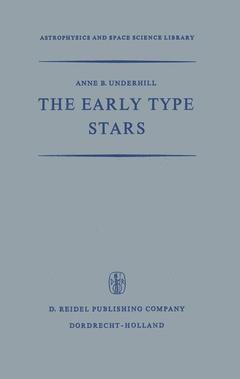The Early Type Stars, Softcover reprint of the original 1st ed. 1966 Astrophysics and Space Science Library Series, Vol. 6
Langue : Anglais
Auteur : Underhill A.B.

At this time when astronomers are being surprised by the discovery of objects which emit a fabulously large amount of energy, that is the quasi-stellar radio sources and the quasi-stellar galaxies, and when by the means of space vehicles X rays, gamma rays and cosmic rays are being observed to come from the depths of interstellar space, one may ask why write a book about stars. Stars seem to be almost incidental when one looks at the universe in terms of exceedingly great energies. Nevertheless, stars exist. They are accessible to study and they have not yet revealed all their secrets. This is enough to arouse interest and to cause one to try to find answers to the questions which arise. The early type stars are particularly interesting because they are spendthrift stars pouring out their energy at a great rate. But their brilliance is also their undoing. They must evolve rather quickly, on an astrophysical scale. Thus by studying these stars we are studying a population in change. The implications from the local and from the cosmological viewpoint are important if one wishes to understand the details of stellar evolution and of galactic structure. Perhaps one of the simplest reasons for writing a book about the early type stars is to see if some of the conundrums pre sented by the spectra of these stars can be unravelled when all the available infor mation is brought together.
I/An Introduction to the Early Type Stars and to the Means of Observing Them.- 1 The early type stars.- 2 Techniques by which information is obtained.- 3 Stellar spectrographs.- 4 The classification and description of early type spectra.- II/Improved Systems of Spectral Classification.- 1 Systems depending upon the visual inspection of spectrograms.- 2 Systems depending upon measured quantities.- III/The Luminosities of the O and B Type Stars.- 1 General principles of calibrating luminosity criteria.- 2 The calibration of the Victoria system of luminosity determination.- 3 Tests of the Victoria system.- 4 The calibration of the MK luminosity classes for B type stars.- 5 The absolute magnitudes of the B type supergiants.- 6 A comparison of Victoria and MK absolute magnitudes for B type stars.- IV/Spectral Studies by Means of Photometry.- 1 Spectral classification and the UBV system of photometry.- 2 Classification by means of narrow-band filters.- 3 Narrow-band photometry by interference techniques.- 4 Observations of OB stars from space vehicles.- 5 The classification problem.- V/Interstellar Material and the OB Stars.- 1 The observation of selective extinction.- 2 The diffuse interstellar absorption features.- 3 The sharp interstellar lines.- 4 Interstellar polarisation.- VI/The Distribution of O and B Stars.- 1 The general distribution of early type stars.- 2 Comprehensive lists of O and B stars.- 3 Some important groups of O and B stars.- VII/The Helium Spectrum.- 1 Spectroscopic notation and the energy level diagram of helium.- 2 Stark broadening and the forbidden lines.- 3 Non-equilibrium effects due to the presence of metastable levels.- VIII/Wave-length Studies of Early Type Stars.- 1 Measurements for wave length.- 2 Standard wave lengths.- 3 The refractivity ofair.- 4 The correction of measured wave lengths to absolute values.- 5 Wave-length and identification lists for O and B stars.- 6 Radial-velocity studies.- 7 Motions of the OB stars.- IX/Spectroscopic Binaries.- 1 Motion in an ellipse and the derivation of an orbit.- 2 Catalogues of spectroscopic and eclipsing binaries.- 3 The secular variation of orbital elements.- 4 The falsification of velocity curves.- 5 Estimates of the masses of the early type stars.- 6 The observed mass-luminosity law.- X/Spectrophotometric Techniques.- 1 Photographic spectrophotometry.- 2 Photoelectric scanning of spectral lines.- 3 Correction for the instrumental profile.- XI/The Interpretation of Normal Main-Sequence Early Type Spectra.- 1 The problem.- 2 Methods of analysis developed at Kiel and the results.- 3 Methods of analysis developed at Michigan and the results.- 4 Methods of analysis developed at Victoria and the results.- 5 The helium abundance.- 6 Other model atmosphere studies of early type stars.- XII/Apparently Unusual Abundances in Early Type Stars.- 1 The helium stars.- 2 Stars with strong lines of Pii and Piii.- 3 The star ? Sculptoris.- 4 B stars in the galactic halo.- XIII/The Wolf-Rayet Stars.- 1 Introduction.- 2 The properties of the Wolf-Rayet stars.- 3 The interpretation of Wolf-Rayet spectra.- 4 Wolf-Rayet binaries.- 5 Some unsolved problems raised by Wolf-Rayet stars.- XIV/Supergiants and P Cygni.- 1 The early type supergiants.- 2 The variability of supergiants.- 3 The interpretation of the spectra of supergiants.- 4 P Cygni.- XV/Be stars, Shell stars, and Of stars.- 1 Stellar rotation and the Be stars.- 2 The Be stars.- 3 Shell stars.- 4 The Of stars.- XVI/The Beta Canis Majoris Stars.- 1 Introduction.- 2 Generalisations.- 3 Observations of individual stars.- 4Theoretical interpretation of the ? Canis Majoris stars.- 5 Stars related to the ? Canis Majoris stars.- Appendix/The Basis of the Theory of Normal Stellar Spectra.- References.- Index of Stars Mentioned in the Text.- Index of Subjects.
Date de parution : 11-2013
Ouvrage de 282 p.
17x24.4 cm
Thème de The Early Type Stars :
Mots-clés :
Libration; Population; Variation; cosmic ray; galaxies; galaxy; star; stars; stellar evolution; universe
© 2024 LAVOISIER S.A.S.



